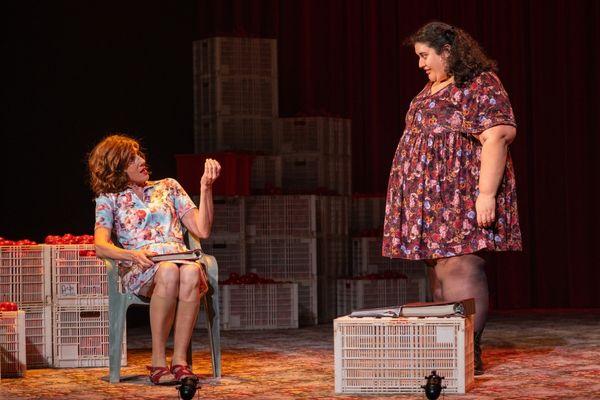'Looking For Alibrandi', the beloved coming-of-age tale of three generations of Italian-Australian women, by Brink Productions and State Theatre Company South Australia, really has some secret sauce.
Directed by Stephen Nicolazzo with a script by Vidya Rajan, this adaptation honours Melina Marchetta’s 1992 novel (and its 2000 film) but adds so much extra flavour. Set in 1990s Australia, the play, with its John Howard and Kylie Minogue references, speaks to both nostalgia and now, inviting audiences old and new to fall in love with teenager of the year Josie Alibrandi’s journey all over again.
At the heart of the production is Chanella Macri, whose portrayal of 17-year-old Josie Alibrandi is disarmingly powerful. From her first moments on stage, Macri commands attention – her Josie is brimming with charisma, frustration, humour, and defiance. Her cultural duality as an Italian-Pasifika woman adds another authentic layer to Josie’s struggle with identity. Rather than fitting into a narrow stereotype, Macri's Josie stands tall – both literally and figuratively – challenging conventions and claiming space.
This height difference is cleverly used in scenes with Lucia Mastrantone, who plays Josie’s mother Christina. Their physical mismatch fuels many comedic beats, with Josie often seeming to parent her own mum, but the reversal also highlights the maturity forced upon Josie in a family shadowed by past shame and silent wounds. Mastrantone delivers a vibrant and nuanced Christina – funny, exasperated, and marked by resilience. She doubles as Josie’s friend Sera with impressive versatility, slipping between characters with sharp comedic timing and emotional truth.
Kate Davis’s set draws from domestic familiarity – piles of tomato crates, a kitchen bench, and sauce-making equipment signal a ritual recognisable to many Italian-Australian families. The play opens and closes with Tomato Day, the family gathered around boiling pots in an act of communal labour and storytelling. This anchoring event becomes a motif not just for tradition, but for the transmission of memory and emotion. A white cloth used during the process becomes a striking symbol, stained red with sauce as the narrative unfolds – suggesting that family stories, like garments and generations, are marked by what they endure.
Throughout the play, sauce-making is more than domestic choreography; it is metaphor. The messiness of crushed tomatoes, the heat, the stains, all mirror the emotional messiness of the Alibrandi legacy. Blood and sauce – love and trauma – coexist in every family pot. Nicolazzo leans into this symbolism without overplaying it, letting imagery speak while grounding the characters in heartfelt interactions.

Image © Matt Byrne
Thematically, the production doesn’t shy away from the darker threads within the Alibrandi lineage. Teen pregnancy, emotional suppression, mental illness, and family violence are handled with subtlety and weight. Josie speaks of the “Alibrandi curse” – a metaphor for the generational silence that binds her family. As the plot unfolds, we learn this curse is not superstition, but a legacy of things left unsaid: forced marriages, parental rejection, and sacrifices buried under decorum.
Jennifer Vuletic as Nonna Katia is particularly compelling in revealing the scars of old-world morality and exile. Her late monologue, dimly lit and underscored by traditional music, is haunting in its stillness. Vuletic embodies a woman caught between regret and survival, her secrets simmering as fiercely as the pots around her. Lighting designer Katie Sfetkidis and sound designer Daniel Nixon work in concert to make these introspective moments resonate. The stage narrows, light fades, and the audience is drawn into a pocket of emotional memory where Nonna’s past becomes uncomfortably present.
The play’s exploration of repression extends beyond the Alibrandis. Josie’s friend John Barton represents another form of inherited expectation – he’s privileged, North Shore Anglo, and outwardly successful, but quietly drowning under the pressure of his family’s ambitions. His storyline, delicately performed, reminds us that cultural silences can take many forms. It is reminiscent of the key arc in 'Dead Poets Society'.
Rajan’s script captures the humour and linguistic playfulness of a bilingual household, with English and Italian blending fluidly. It adds texture and realism without alienating audiences. Scenes peppered with Italian expressions – sometimes untranslated – draw the audience closer to the domestic core of the story. This authentic portrayal of language is one of the play’s quieter triumphs, inviting us into a home where communication isn’t always clean, but always layered with emotion.
Nicolazzo directs with flair and feeling. His touch is visible in the theatrical pacing and the care with which emotional peaks are framed. The comedy lands with precision, but it's the quieter moments – those of stillness, shame, or reconciliation – that linger. His direction allows the actors to explore vulnerability without veering into melodrama, giving the production an emotional elasticity that keeps the audience engaged throughout.
Ultimately, this production of 'Looking For Alibrandi' is vibrant, relevant, and deeply felt. It embraces the source (sauce) material’s iconic status while reshaping it for the stage with a fresh lens. From the sensuality of sauce-making to the sting of unsaid truths, the play honours what it means to come of age in a world shaped by family, culture, and contradiction. It’s a production as rich as a pot of Nonna’s sugo – deeply flavoured, simmered with love, and impossible to forget. Much better than the store bought Leggo’s.
★★★★★






